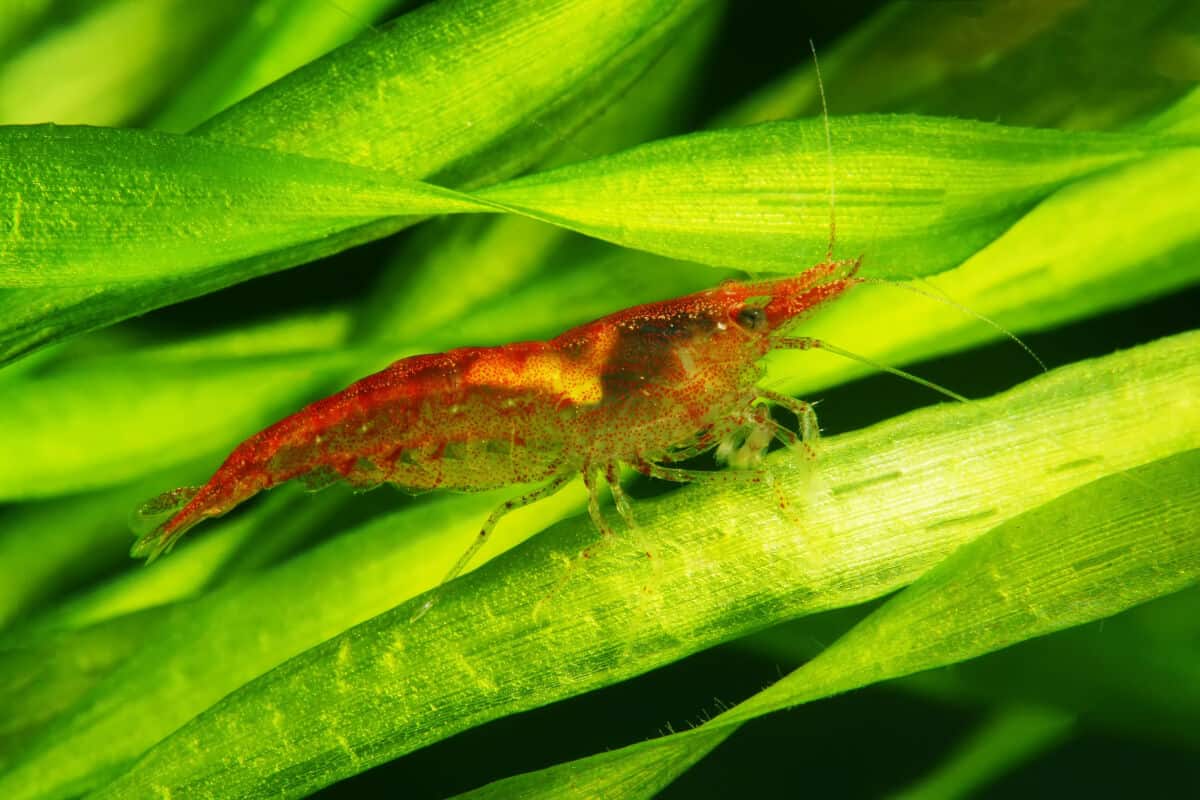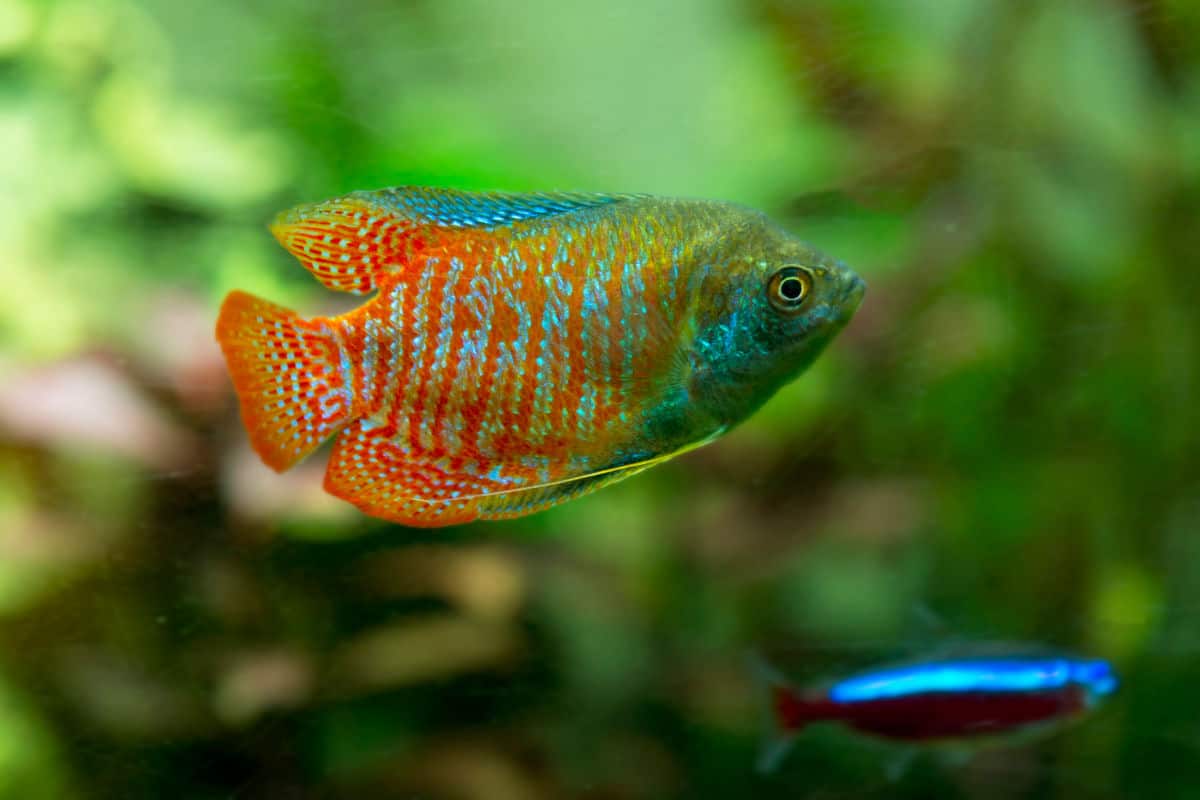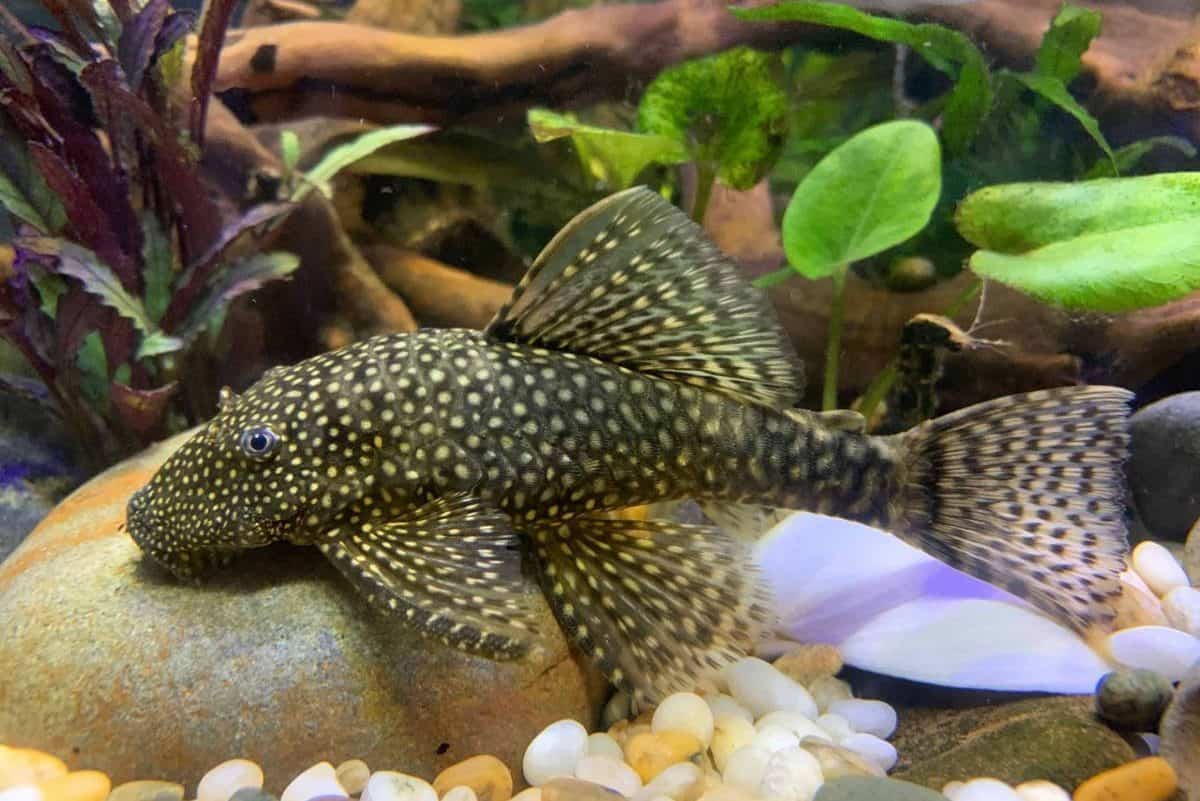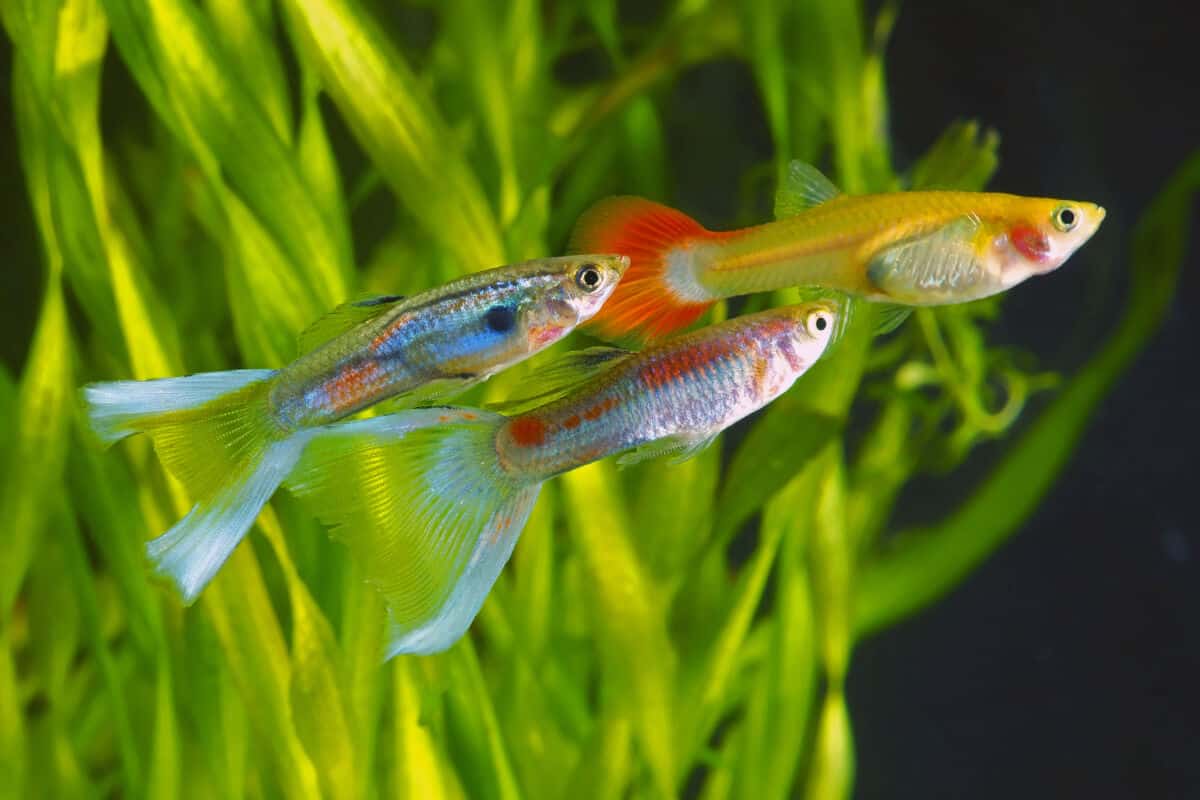Red cherry shrimp are a great addition to a freshwater tank. Not only do they provide a gorgeous splash of color to your aquarium, but they’ll also help keep your tank clean.
Like many other species of shrimp, they are omnivores. They will happily make a dent in any plant debris and algae matter that’s trying to set up shop in your tank.
While they won’t replace regular good aquarium cleanings, they’ll make your task of maintaining the aquarium a little easier.
In the following article, we’ll look at everything you need to know about red cherry shrimp care. We’ll explore their preferred living conditions, dietary needs, and expected behaviors.
They are active, easy to breed, and thrive in a heavily planted environment. They can be the perfect addition to a community tank.
The following information can help you seamlessly integrate your red cherry shrimp into your home aquarium.
Overview and Statistics
In the table below, we’ve summarized the most important information for your reference.
| Characteristic | Details |
|---|---|
| Common name(s): | Red cherry shrimp, cherry shrimp |
| Scientific Name(s): | Neocaridina denticulata sinensis |
| Family: | Atyidae |
| Origin: | Singapore |
| Care Level: | Easy to moderate |
| Temperament: | Peaceful |
| Adult Size: | 1.5 inches |
| Color Form: | Red |
| Lifespan: | 1–2 years |
| Minimum Tank Size: | 10 gallons |
| Typical Tank Setup: | Plenty of hiding places—for example, plants and rocks, and algae to snack on |
| Tank Level: | Bottom |
| Diet: | Omnivore |
| Water Conditions: | Freshwater, 60–80° F, KH 3–10, pH 6.6–7.0 |
| Tank mates / Compatibility: | Well-suited for community tanks and peaceful fish—avoid keeping with aggressive fish like loaches and puffers as they will likely be eaten. |
They originated in Singapore Their attractive coloration and helpful contribution to home aquariums has led to their growing popularity.
They are easy to breed, even for the novice keeper. Unlike some other varieties, they do not go through a larval stage. Rather, new shrimp emerge as miniature adults—they are easy to care for and attempts to raise to adulthood are frequently successful.
Suitable for all experience levels and a variety of aquarium setups, they can be a fun addition to your home aquarium.
Appearance
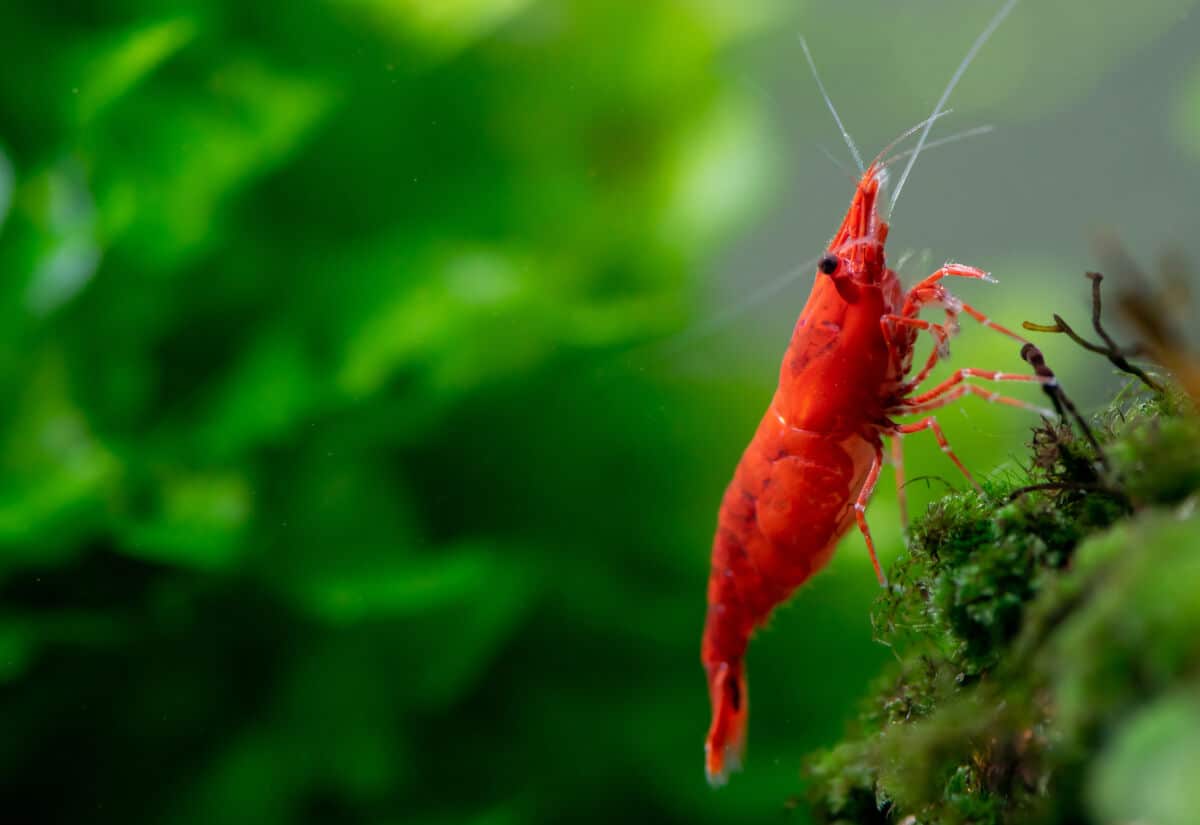
As their name suggests, they are frequently red in color. Not all are created equal though, and there is a grading scale that reflects their coloration.
- Cherry—this is the lowest grade of red cherry shrimp. They are predominantly transparent with some red speckling.
- Low Sakura—low grade. These will have a lighter red body, though there may still be some transparency, especially through the lower half of the body and legs.
- High Sakura—mid grade. These will be mostly red with minimal transparency.
- Fire red—high grade. These will be completely red with no transparency or coloration flaws.
- Painted fire red—highest grade. This category is top grade. Like the fire red, these will be entirely red without color flaws. Their color will be a deeper, richer red with an opaque shell.
While adjusting to a new environment, you may see their color fade to white or even translucent. Give them some time to acclimatize to their new home, and you can expect their vibrant trademark coloring to return.
Like other shrimp, red cherrys are invertebrates. Their bodies are segmented. The carapace supports the walking legs, while the abdomen is where the pleopods, or swimming legs, are located. They also have two sets of antennae and a tail.
It may be difficult to tell your males and females apart, but there are some indicators of sex to look for. Females will have a curved underbelly while males have a straight underbelly. Males will also have longer antennae. You may notice your females have a deeper color to them too.
Red cherrys are a dwarf shrimp and remain quite small. Care should be taken when selecting appropriate tank mates for them so they are not eaten. Read on for more information on this subject.
Behavior and Temperament
They spend their time at the bottom of the tank. While they’re down there, they consume any algae and debris they come across. If you have plants and other items in the tank, it is possible they will climb on them.
They are alert and active. Peaceful in temperament, they are quite aware of their surroundings and any nearby threats. Like other shrimp, they’re able to retreat backward in a quick burst to help evade predators.
They are quite curious and invested in their environment. They spend a tremendous amount of their time scavenging and eating—this serves to help keep your aquarium clean.
As they grow, they will molt they hard exoskeleton. During this time, while they grow their new protective shell, they are more vulnerable than usual. It’s likely you will find their discarded shell and not see them for a few days while they seek shelter until their new shell is fully formed.
Habitat and Tank Requirements
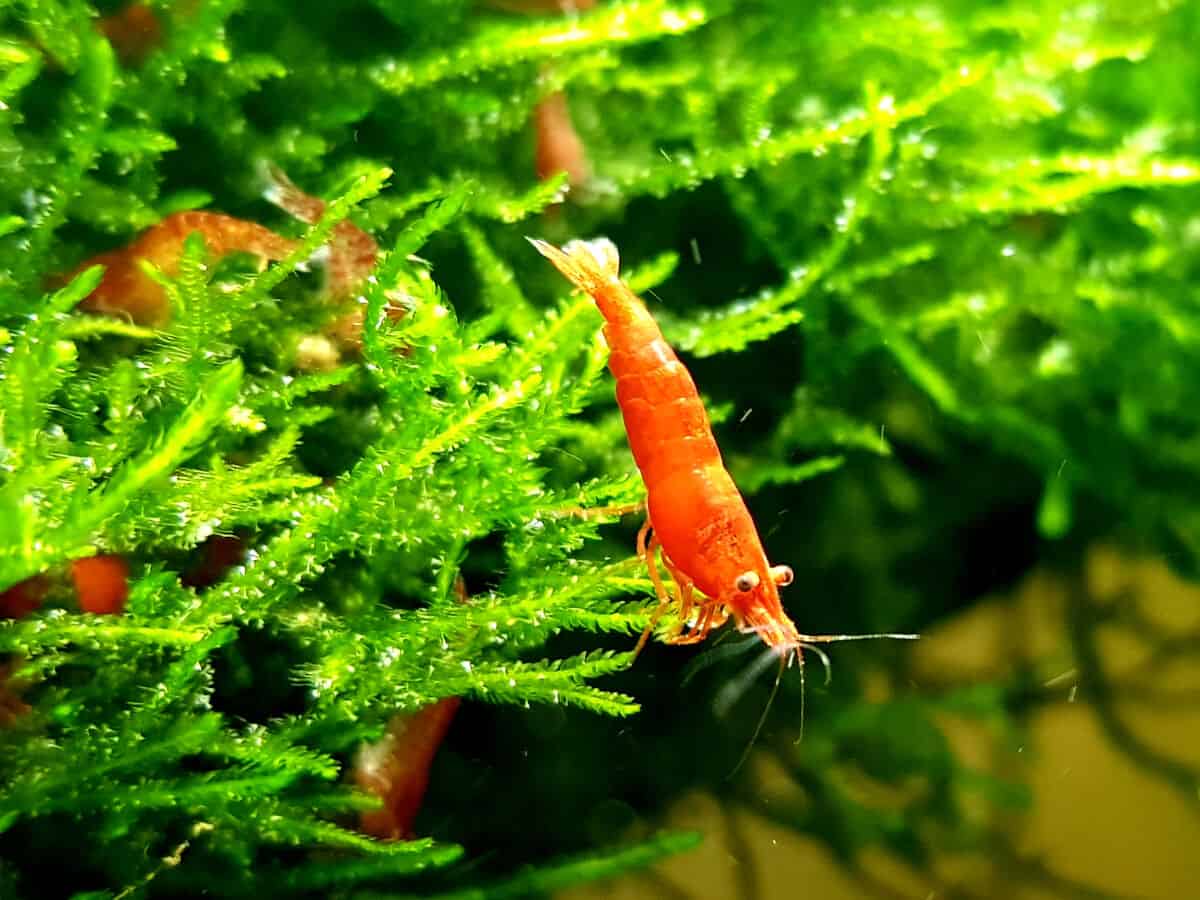
They are originally found in fesh water in Singapore. They can do well in cooler water temperatures and prefer a well-planted tank.
To do best fior them, you’ll want to plan on replicating their natural environment as closely as possible.
What Size Tank do Your Red Cherry Shrimp Need?
As bottom dwellers, you will need to pay attention not only to the volume of water a living space can accommodate but also the surface area of the base. A longer tank will serve them better, even if the water is less deep.
The minimum size requirement is 10 gallons. A small number can do well in small living quarters. However, it’s important to remember that they reproduce often and well, with survival rates that are quite high.
Many owners report their small numbers quickly multiplied to a much larger population. If you have breeders in your tank, you may need to have a plan for relocating some of your fry.
While they can be kept in small tanks, they also do well in larger ones, especially community tanks. You can enjoy having one or two in your aquarium to help maintain the cleanliness, though a breeding pair may lose fry to other fish.
Water Type and Parameters
The red cherry is a freshwater shrimp that does well in waters between 60 and 80 degrees Fahrenheit. The KH should be between 3 and 10 while the pH should be between 6.6 and 7.
While they thrive in a wide range of water types and temperatures, they do not do well with abrupt changes to the water. Any water parameters that need to be changed should be altered slowly, to avoid harming your shrimp population.
Red cherrys do well with strong filtration systems and are quite sensitive to copper and nitrates in their water. As a best practice, you’ll want to monitor these qualities closely.
What Substrate Should You Provide Them?
They can be housed successfully with a variety of substrates. However, replicating their natural environment involves having a well-planted tank. To successfully grow plants you’ll want a substrate that can support plant life.
For healthy plants—and in turn, healthy shrimp—you’ll want a nutrient-rich substrate. Specialty substrates are geared toward plant growth. If you would like to add a top layer of decorative substrate, that is certainly possible. In this case, top layers of both sand and gravel will suit.
If you’re looking for an extra spot of color, consider using a dark substrate. The red of even your low-grade red cherrys will look quite pronounced against the dark base. Coupled with rich greenery, this can make for a show-stopping tank backdrop for your red cherry shrimp.
Filtration Requirements
They do best in well-filtered waters. That being said, it can sometimes be difficult choosing the best filter for your shrimp.
Strong filters, like a good canister filter, provide excellent clean and stable water parameters, but unfortunately, these filters can also be strong enough to suck in unsuspecting shrimp, especially young or small ones.
It’s often recommended that you use a sponge filter instead. This will help protect young and small ones from the filter. The sponge filter may not provide the level of filtration you need, however, if your shrimp are kept with dirty fish.
If that’s the case and you need greater filter power, opt for a canister filter instead. You’ll need to plan on having a separate breeding tank with a sponge filter if you do decide to breed them. This will help protect young fry from being accidentally lost to your filtration system.
Lighting Requirements
This is another time where replicating their natural environment will dictate the amount of light you need. Your planted tank is going to need access to light to grow successfully.
How much light your aquarium needs will come down to the needs of the specific plants you decide to use. In most cases, you will find that a wide variety of plants respond well to a moderate amount of light.
LED lights can be a great option for your tank. Not only do they require less energy to run, but they also create less heat. This can be an important factor when choosing your tank’s lighting needs.
Plants, Decorations, Swims, And Open Spaces
While it may be more of a hassle to set up—and even add some additional expense— the truth is that shrimp do much better in tanks with natural plants.
While decorative plants and items can provide needed hiding spaces, they don’t provide additional aeration and food sources like live plants do. As part of the optimal set up for red cherry shrimp care, we recommend using plenty of live plants.
They can also be vulnerable to larger fish when kept in a community tank. Along with their vulnerability after molting, we suggest you keep plenty of protective hiding spaces for them.
Java moss is very popular for shrimp tanks. It provides plenty of hiding spots and acts as a food source. It’s also beginner-friendly and does well in a wide variety of setups.
How Many Red Cherry Shrimp Can You Have Per Gallon?
They only add a small bioload and don’t need a tremendous amount of space. They are peaceful and willing to share their space with other species.
If you are keeping only red cherry shrimp in your tank, you can plan to allow for five per gallon. You will need to make sure you have at least 10 gallons to house them in, though. Of course, if you are keeping a community, you will need to keep in mind the space needs of the tank mates as well.
Don’t forget—they are easy breeders. If you’ve created an inviting environment for them, they will likely reproduce. Make sure you have a plan for your extra shrimp if you have a breeding pair in your tank.
Diet and Feeding
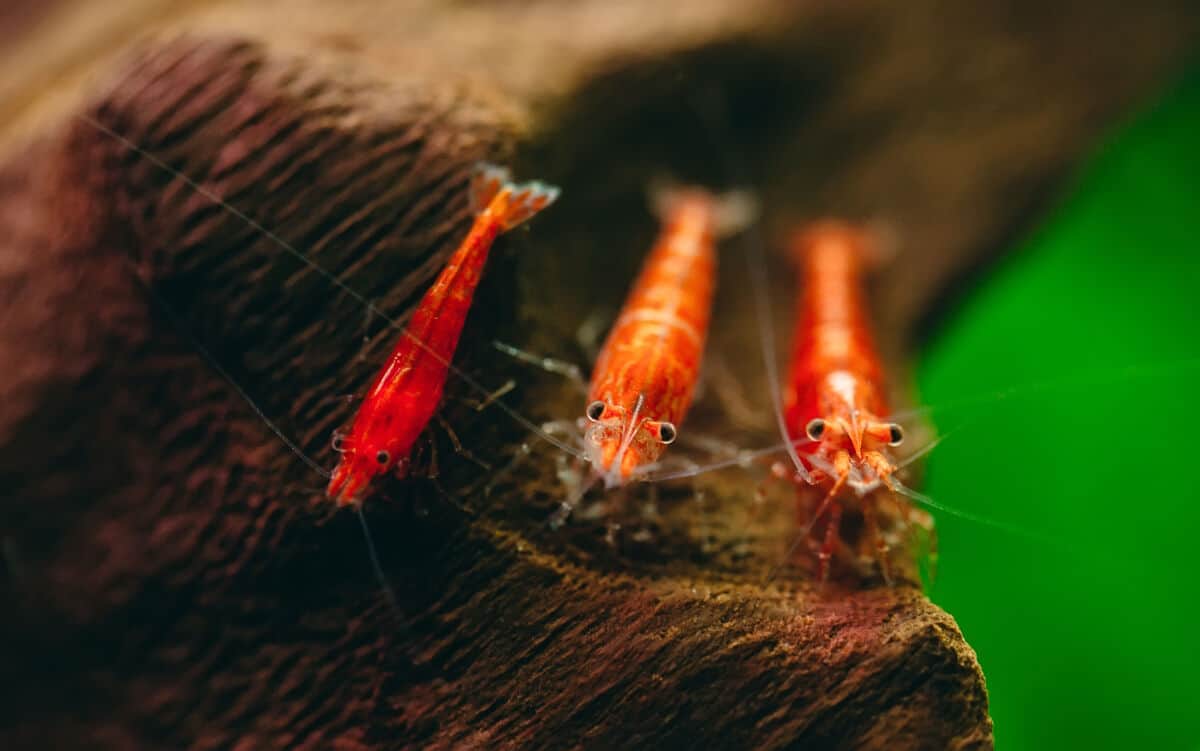
They are omnivores and scavengers. They will spend their days cleaning up organic debris from your tank and leaving things cleaner than they found them.
While they are happy to munch on items around the tank, you should also plan on providing them with a commercially available shrimp feed.
What do They Eat in the Wild?
In the wild, they are proficient scavengers. Most of what they come across can become a meal. They will eat plants, detritus, algae, small insects, and worms. They are not above eating the occasional carcass.
What Can You Feed Them at Home in Your Aquarium?
In a home aquarium, they will continue their scavenging. They will eat leftover fish food, algae growing along the bottom of your tank, and munch on your plants.
For optimal care, though, you should plan on feeding them a shrimp-specific commercially available food. This will ensure they are getting the nutrients they need.
What Human Foods Can They Eat?
As omnivores, they would be happy to eat much of what you keep in your refrigerator. Blanched vegetables can be a great option. Cucumbers, zucchini, and spinach are usually well received.
These veggies can be a great way for your shrimp to have a varied diet and receive extra nutrients. However, you will need to remove uneaten food after 24 hours. This will help prevent sudden changes in the water parameters and keep your tank from being soiled.
How Often Should You Feed Them?
You can plan on feeding them once a day or every other day.
Overfeeding can cause problems for your water parameters, so it’s important to feed just what they’ll eat. Plan to remove whatever pellets have not been eaten in the first 20 minutes, and any fresh produce after 24 hours.
Do They Have any Special Care Requirements?
They are highly sensitive to nitrates and copper. They are also vulnerable to most medications used for treating sick fish. Keep an eye on your water levels and separate your shrimp when treating fish for illness.
When you go to return your shrimp to the fish tank, make sure the water parameters are very close or identical. This will provide the easiest transition and help prevent shock or illness.
Red Cherry Shrimp Tank Mate Compatibility
They get along with most other peaceful community fish.
You will want to make sure not to keep them with large fish that can fit the entire shrimp in their mouth. While these large fish may be peaceful, they may also be hungry and make a snack out of them. Aggressive fish like cichlids should be avoided.
Plecos, danios, and otocinclus can all make excellent tank mates. They can also be kept with other shrimp. In those instances, you will want to stick with only either females or males, not a mix of the two, because it’s likely they’ll interbreed.
Interbreeding between colorways can lead to dull or weakly colored offspring. If you’re looking for that pop of color, it’s best to stick to a single species per tank.
Can You Keep Multiple Red Cherry Shrimp Together?
Yes, they can be kept together. They can even be kept with other types of dwarf shrimp, but again, you will want to take care to avoid interbreeding.
Buying Advice
They may be readily available for purchase at your local fish supplier. But if you’re looking for a higher grade—or better quality for breeding purposes—you may have better luck purchasing them from an online source.
When shopping for them in person, you’ll want to make sure they are well colored and active. You may notice a change in coloration as they get settled in their new tank. This is normal and, once they’ve acclimated, their color will return.
They are quite affordable and can cost as little as a few dollars. That being said, you can expect to pay more for higher quality, better-colored individuals. Especially if you plan to breed (or sell) them, consider paying more upfront for better stock.
Breeding
They are prolific and easy breeders. Most of the time you will need to do very little to successfully breed your shrimp.
It’s unlikely you will need to induce breeding. If you do, though, this can be achieved by bringing the water temperatures up to the higher end of their preferred range. This will simulate their natural summer breeding season and encourage breeding.
If your shrimp are in a community tank, you may want to consider keeping them in a breeding tank. In a breeding tank, you can protect the young from other fish and use a sponge filter to prevent accidental loss.
Provide plenty of live plants. These plants will this give them the hiding places they need to feel comfortable and to reproduce. Plants will also act as a food source for young fry.
You can make sure your shrimp are in prime breeding condition by feeding frequent small meals. The female will carry her eggs with her along her abdomen near her tail.
There will be 20–30 fry per hatch and you can expect them to hatch in about three weeks. Unlike other varieties, red cherry shrimp do not go through a larval stage. Your fry will emerge like tiny replicas of the adults.
New fry will eat what your adult fry eat. You’ll find they require little care concessions, other than hiding places to protect them from fish predators.
Interesting Facts and Trivia
- Females will abandon their eggs if they feel threatened.
- Molted skins should be left in the tank—they can receive valuable nutrients by consuming them.
- The color of your shrimp will be influenced by water parameters and diet.
- Shed exoskeletons look shockingly like your living red cherry shrimp.
- A diet with high protein can lead to a brighter and richer exterior color.
- They excrete a mucus that helps protect them from disease and bacteria.
- Like most fish, they breathe through the use of gills.
Summary
Red cherry shrimp can be an attractive and helpful addition to your tank. Whether you’re interested in an aquarium that contains only shrimp, or you’re looking to add a few to your community tank—these are a great option.
You don’t need to be an experienced fish keeper to bring home red cherry shrimp. They are beginner-friendly, tolerant, and quite hardy. Just keep in mind that all changes to their water should be made slowly and that they love live plants. Your shrimp population should thrive as long as you have no predators in the tank with them.
Do you keep red cherry shrimp in your tank? Have another variety you prefer? We’d love to hear your experiences. Leave us a comment below with tips or anything we may have missed.
Happy fish keeping!

